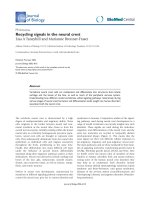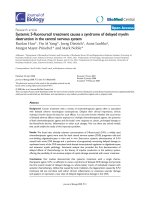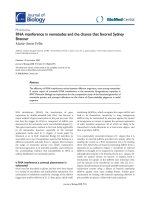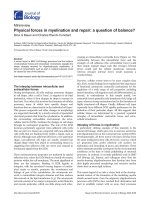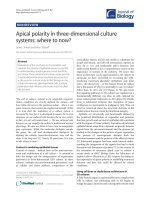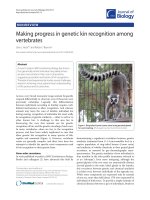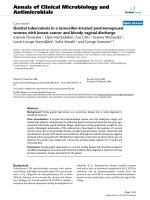Báo cáo sinh học: "Robertsonian translocation in Holstein-Friesian cattle A Ducos" doc
Bạn đang xem bản rút gọn của tài liệu. Xem và tải ngay bản đầy đủ của tài liệu tại đây (403.49 KB, 5 trang )
Note
A
new
Robertsonian
translocation
in
Holstein-Friesian
cattle
A
Pinton
A
Ducos
HM
Berland
A
Séguéla
MF
Blanc
A
Darré
S
Mimar
R.
Darré
1
Unité
de
recherches
associée
ENVT-Inra
de
cytogénétique
des
populations
animales,
23,
chemin
des
Capelles,
31076
Toulouse
cedex
3;
2
Service
de
zootechnie,
Enfa,
BP
87,
31326
Castanet-Tolosan
cedex,
France
(Received
2
December
1996;
accepted
21
April
1997)
Summary -
A
new
Robertsonian
translocation
was
found
in
a
cow
of
the
Holstein-Friesian
breed.
GTG-banding
allowed
us
to
elucidate
the
anomaly
as
a
centric
fusion
between
chromosomes
19
and
21.
CBG-banding
demonstrated
that
the translocated
chromosome
was
dicentric.
Cytogenetic
investigation
of
the
relatives
of the
translocated
animal
revealed
two
other
carriers.
cattle
/
Holstein-F’riesian
/
chromosome
/
Robertsonian
translocation
Résumé -
Une
nouvelle
translocation
robertsonienne
dans
la
race
Prim’Holstein.
Une
nouvelle
translocation
robertsonienne
a
été
mise
en
évidence
chez
une
vache
de
race
Holstein.
La
coloration
en
bandes
GTG
nous
a
permis
d’identifier
les
chromosomes
impliqués
dans
la
translocation.
Il
s’agit
des
chromosomes
19
et
21.
La
coloration
en
bandes
CBG
montre
que
le
chromosome
transloqué
est
dicentrique.
Une
analyse
cytogénétique
des
apparentés
de
l’animal
porteur
a
permis
de
mettre
en
évidence
aeux
autres
animaux
porteurs.
bovin
/
Holstein
/
chromosome
/
translocation
robertsonienne
INTRODUCTION
The
first
Robertsonian
translocation
described
in
cattle
was
the
1/‘?9
translocation
resulting
from
a
centric
fusion
between
chromosomes
1
and
29,
with
a
single
heterochromatic
block
(Gustavsson
and
Rockborn,
1964).
Since
that
date,
this
anomaly
has
often
been
reported
and
occurs
in
many
dairy
and
beef
cattle
breeds
(Long,
1985).
However,
the
1/29
translocation
has
never
been
reported
in
the
Holstein-Friesian
breed.
Up
to
now,
only
four
types
of
Robertsonian
translocations
have
been
identified
in
the
Holstein-Friesian
breed:
rob(13;
21),
Kovacs
et
Papp,
*
Correspondence
and
reprints
(1977);
rob(14;
28),
Ellsworth
et
al
(1979);
rob(1;
26),
Miyake
et
Kaneda,
(1987);
and
rob
(1;
21),
Miyake
et
al
(1991).
The
demonstrated
or
putative negative
effect
of
the
Robertsonian
translocations
on
fertility
(Long,
1985;
Darr6
et
al,
1990)
incited
some
breeders
to
set
up
rou-
tine
animal
testing
procedures.
This
allowed
us
to
observe
a
new
Robertsonian
translocation
in
a
7-year-old
(6th
lactation)
Holstein-Friesian
cow.
The
translo-
cated
chromosomes
analysed
by
GTG-banding
resulted
from
the
centric
fusion
of
chromosomes
19
and
21.
Twenty-five
relatives
of
the
translocated
animal
were
kary-
otyped
to
determine
the
origin
of
the
anomaly.
MATERIAL
AND
METHODS
Mitotic
chromosomes
were
prepared
from
non-synchronized
cultures
of
periph-
eral
blood
lymphocytes,
or
from
synchronized
cultures of
skin
fibroblast.
Whole
blood
was
cultured
at
37°C
for
72
h
in
RPMI
1640
medium
supplemented
with
20%
fetal
calf
serum,
500
UI
Heparin,
1%
antibiotic-antimycotic
solution
(Gibco),
and
stimulated
with
Concanavalin
A
(final
concentration:
0.3
vg/L).
Colcemid
(final
concentration
0.03
vg/L)
was
added
to
the
culture
60
min
before
harvesting.
Pri-
mary
fibroblast
cultures
were
initiated
from
skin
fragments,
disrupted
and
digested
in
a
trypsin
solution
(2.5
g/L),
and
grown
at
37°C
in
a
C0
2
incubator
in
Falcon
dishes
(75
cm
2)
containing
a
medium
comparable
to
that
previously
described
for
lymphocyte
cultures
(RPMI
1640
replaced
by
Ham’s
F12).
Hypotonic
treatment
(10
mL
1/6
calf
serum)
was
followed
by
pre-fixation
and
fixation
in
ethanol/acetic
acid
(3:1).
Chromosome
preparations
were
spread
on
cold
wet
slides
and
air
dried.
After
overnight
incubation
at
60°C,
the
preparations
were
treated
for
GTG
banding
according
to
Seabright
(1971),
and
for
CBG
staining
according
to
Summer
(1972).
Chromosomes
were
arranged
according
to
the
standard
nomenclature,
ISCNDA
(1990).
RESULTS
AND
DISCUSSION
Giemsa
staining
of
preparations
revealed
59
chromosomes
including
a
new
metacentric
chromosome
similar
in
size
to
the
X-chromosome
(fig
1).
GTG-banding
allowed
us
to
elucidate
the
anomaly
as
a
centric
fusion of
chromosomes
19
and
21
(fig
2).
CBG-banding
showed
that
the
translocated
chromosome
was
dicentric
(fig
3).
This
may
suggest
that
the
anomaly
occurred
recently
(Eldridge,
1985).
Cytogenetic
studies
of
relatives
were
carried
out.
The
anomaly
was
found
in
two
other
animals
of
the
same
herd;
an
offspring
and
a
maternal
half-sister
of
the
cow.
All
the
carrier
animals
were
phenotypically
normal
and
appeared
healthy.
The
presence
of
the
translocation
in
one
maternal
half-sister
seemed
to
indicate
maternal
origin
of
the
anomaly.
Unfortunately
the
dam
had
died.
Investigations
in
the
maternal
grandam-offspring
were
carried
out
(N
=
13)
but
all
the
animals
demonstrated
a
normal
karyotype.
For
diverse
reasons,
it
was
not
possible
to
investigate
the
paternal
side
of
the
offspring
and
ancestors
for
this
anomaly.
The
effects
of
this
translocation
on
fertility
have
still
not
been
analysed.
ACKNOWLEDGMENTS
The
authors
are
indebted
to
JL
Gu6rin
for
the
skin
biopsy.
We
also
thank
the
reviewers
for
their
helpful
comments
on
the
manuscript.
Darre
R,
Gary
F,
Berland
HM,
Concordet
D
(1990)
Frequency
and
effects
of
the
1/29
Robertsonian
translocation
in
the
Blonde
d’Aquitaine
breed.
In:
9th
European
Collo-
quium
on
Cytogenetics
of
Domestic
Animals,
Toulouse,
7-13
July
1990,
INRA,
24
Eldridge
FE
(1985)
Cytogenetics
of
Livestock.
AVI
Publishing
Company
Inc,
Westport,
1st
ed
Ellsworth
SM,
Paul
SR,
Bunch
TD
(1979)
A
14/28
dicentric
Robertsonian
translocation
in
a
Holstein
cow.
Theriogenology
11,
165-171
Gustavsson
I,
Rockborn
G
(1964)
Chromosome
abnormality
in
three
cases
of
lymphatic
leukaemia
in
cattle.
Nature
203,
990
ISCNDA
(1990)
International
system
for
cytogenetic
nomenclature
of
domestic
animals.
Cytogenet
Cell
Genet
53,
65-79
Kovacs
A,
Papp
M
(1977)
Report
on
chromosome
examination
of
AI
bulls
in
Hungary.
Ann
Genet
Sel
Anim
9,
528
Long
SE
(1985)
Centric
fusion
translocation
in
cattle:
a
review.
Vet
Res
116,
516-518
Miyake
YI,
Kaneda
Y
(1987)
A
new
type
of
Robertsonian
translocation
(1/26)
in
a
bull
with
unilateral
cryptorchidism,
probably
occurring
de
novo.
Japanese
J
Vet
Sci
49,
1015-1019
Miyake
YI,
Murakami
RK,
Kaneda
Y
(1991)
Inheritance
of
the
Robertsonian
Transloca-
tion
(1/21)
in
the
Holstein-Frisian
Cattle.
I.
Chromosome
analysis.
J
Vet
Med
Sci
53,
113-116
Seabright
M
(1971)
A
rapid
banding
technique
for
human
chromosomes.
Lancet
II,
971-
972
Summer
AT
(1972)
A
simple
technique
for
demonstrating
centromeric
heterochromatin.
Bay
Cell
Res
75,
304-306
In
the
article
’ECM
approaches
to
heteroskedastic
mixed
models
with
constant
variance
ratios’
by
JL
Foulley,
Genet
Sel
Evol
(1997),
29,
297-318,
one
should
read
Formula
(11!:
Appendix:
Derivatives
with
respect
to
5
Derivatives
with
respect
to
T
(ratio)

